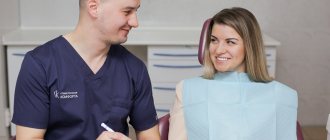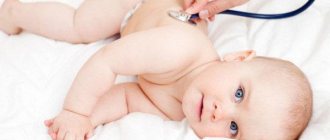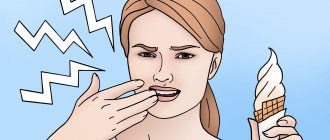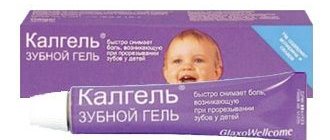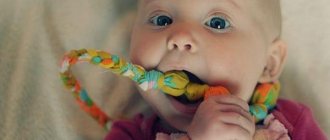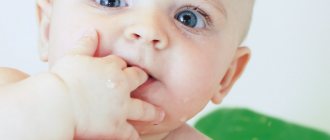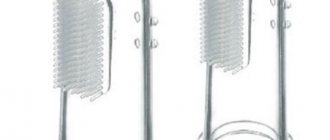How to help your child with medicine when teething
For some children, homemade recipes and other non-drug methods do not help. This is due to the different sensitivity and susceptibility of the body of small patients. All medications should be selected exclusively by a doctor. It is likely that the infant has a history of chronic and other diseases for which drug therapy is strictly contraindicated. Self-prescription of pharmaceutical products can lead to allergic reactions and other side effects, so it is better not to rely on reviews on the Internet and advice from other mothers. Let's look at how to help a child teething with the help of medications.
Kalgel
The combined gel has an anesthetic and anti-inflammatory effect. The active ingredient is lidocaine, that is, inflamed and swollen gums seem to be “frozen.” Sold exclusively with a doctor's prescription. It is necessary to observe the exact dosage and avoid excessive use. The effect lasts for a long time.
Kamistad
Produced in Germany. The principle is almost identical to the previous drug, but the composition contains harmless polidocanol and tincture of chamomile flowers. Herbal components help eliminate pain, itching, inflammation, swelling and redness. The composition is sweet, so the little patient will not spit it out and will be happy to open his mouth. It is often prescribed by doctors for diseases of the oral cavity.
Holisal
The gel-like substance contains choline salicylate and auxiliary components. Prescribed also for adults. Allowed for use over six months of age. It acts quickly and relieves a wide range of dental problems. This is one of the best remedies for pain relief when a child is teething badly. The disadvantage is the higher cost compared to analogues.
Dentinox
A paste based on lidocaine and chamomile extract disinfects treated surfaces of the oral cavity, relieves pain and swelling of soft tissues. Unpleasant sensations are eliminated in a short period of time, the baby sleeps soundly, does not cry for no reason, and happily eats mother's milk or an adapted formula from a bottle. Since the gel is applied externally, it is completely safe when used in moderation.
Effective rituals
For teeth growth
To increase the growth rate of primary molars in children after the loss of baby teeth, you can perform a ritual. But to carry it out, you need to be sure that you respect your brownie, otherwise he will not help you. This is an appeal to the invisible owner of the house. You will need a child's milk tooth, a silver tea spoon, a church candle and honey. Only a close relative of the child should carry out a conspiracy to grow new teeth.
Light a candle, let a milk tooth live on a teaspoon. Next, bring the spoon to the candle flame and heat it up a little. Take out the tooth and dip it in honey. Then take it out of the container with honey and hide it in a secret place, while saying a spell for new teeth:
“Brownie, you are the owner of my house, you protect us all from all evil, you keep the house clean and in order, you help us find what we have lost. Now I have a special request for you. I’ll give you my baby’s milk tooth, and you give him strong, strong and healthy teeth. May they never spoil, hurt, break or rot. Let it be so".
Repeat the spell on new teeth three times. All words must be pronounced clearly, without changing places. It is important to be alone in the room so that no one distracts or interferes. It is recommended to appease the brownie before performing the ritual and provide him with a treat for the night. In the morning, give food to dogs or birds. Perform magical actions at night.
Folk remedies
Medicines are effective for teething, but what should you give a child when teeth are cutting and you don’t want to use synthetic drugs? Home methods are auxiliary because they cannot always completely eliminate pain. However, for some children, these options are the most preferable and really help cope with pain. Doctors sometimes advise using:
- Compresses with chamomile. It is necessary to moisten a bandage or cotton pad in chamomile infusion and then apply it to the painful cheek. To relieve inflammation and swelling, dentists recommend giving several teaspoons of herbal tea.
- Honey. If the baby is not prone to allergic reactions, you can lubricate the inflamed mucous membranes with a honey substance. You should rub the substance in carefully, otherwise the baby will simply swallow it, and all manipulations will be useless.
- Soda solution. It is recommended to dissolve 1 tsp. soda in a glass of clean warm boiled water, dip a gauze cloth and wipe the gums. This product helps not only relieve pain, but also disinfect the surface.
Before using traditional methods, you must always consult a doctor, even if the herbal substances used are considered completely safe. Sign up for a consultation at the dental office, our specialists will recommend effective formulations that will not harm the little patient.
Urticaria and food allergies in infants
26.05.2021
Urticaria in a child manifests itself as itching, redness, and blisters. It is not uncommon, but in some cases it can be dangerous. One of the symptoms of hives may be a food allergy . Its presence requires certain changes in the diet of the baby, and often his mother. What to do if you suspect a food allergy in a child and how to recognize its symptoms?
Urticaria in a child
The name "urticaria" is no coincidence, because the changes caused by it are similar to those that can be observed as a result of skin contact with nettles. Red, itchy blisters may appear in different places on the body, changing their location over the following days. Urticaria in a child is equivalent to an allergy . One of the most common is food allergies , but children, like adults, can be allergic to dusty plants, animal dander, and dust. Babies' skin is also often irritated by the use of cosmetics or washing powders.
There are several types of urticaria . Acute urticaria in a child appears on the skin as a result of a specific reason and lasts from several days to 1.5 months. Blisters on the skin can persist for more than 6 weeks. urticaria occurs . In idiopathic urticaria, the cause of the disease is unknown, which makes the treatment of skin lesions difficult.
Urticaria in a child can be dangerous if it is accompanied by swelling and rashes around the throat . It can even lead to suffocation. It is worth knowing that the cause of urticaria is not only an allergy , but also a reaction to low or high temperature, exposure to solar radiation, under pressure, as a side effect of medications.
Food allergies in infants
The hives described above are one of the symptoms of food allergies , which can be associated with digestive and breathing problems. Usually this:
- colic;
- flatulence;
- diarrhea;
- constipation;
- cough;
- juice.
Food allergies in an infant often occur when new foods are added to their diet, but can also appear in the first months of life. It is believed that the safest way to prevent allergies is to breastfeed your baby for the first six months of his life. However, it is worth noting that food allergies in a newborn can also arise as a result of foods consumed by the mother. The most common allergens include: cow's milk, eggs, grain products containing gluten, nuts, fruits such as strawberries, bananas or citrus fruits, fish and seafood.
An elimination diet is quite simple to implement when parents introduce new foods into their child's diet one at a time. Then careful observation is enough to determine the causes of food allergies . For the same reason, breastfeeding women should pay close attention to their diet and closely monitor their baby's reactions. In case of milk allergy The tendency to allergies is not always hereditary, but its presence in parents increases the likelihood of allergic reactions in the child.
Treatment of food allergies in infants
In the case of food allergies, the procedure seems clear - just avoid the factor that provokes an abnormal reaction of the immune system . However, if it is impossible to eliminate the allergenic factor, antihistamines are used. Their task is to suppress the secretion of histamine, a substance responsible for the occurrence of hypersensitivity reactions. The same treatment is used for allergic urticaria . For other types of urticaria , it is essential to make an appropriate diagnosis, which then determines treatment or specific preventive measures. Blood tests help determine the causes of hives .
Published in Allergology Premium Clinic
How to calm your baby
Many young mothers worry about what to do and how to alleviate the condition when the child is teething, because he screams loudly and cannot sleep or eat normally. The best way to help a newborn is to breastfeed frequently. During the sucking process, the baby calms down, feeling maternal protection and love.
Parents may notice that regurgitation has become a common occurrence at this time. This feature is associated with abundant salivation and is quite natural. It is important not to confuse the periodic passage of air and food with vomiting, which is dangerous to life and health due to the high risk of dehydration.
What are the symptoms of teething?
If a child’s first tooth does not come out by 5–6 months, then parents, as a rule, are already expecting its appearance and monitoring the baby’s condition. Often it is the first teeth that are painful.
During this period, children are overly capricious and cry a lot. Teething can be distinguished from another pathology in a child who, due to his age, cannot speak, by the accompanying symptoms.
Associated symptoms of teething in a child:
- the gums swell and the mucous membrane swells in the place where the tooth appears;
- salivation increases;
- body temperature can be from 37 to 39 degrees;
- sleep is disturbed;
- no appetite;
- stool is disrupted (diarrhea is more common);
- the throat turns red;
- nasal congestion appears;
- there may be watery nasal discharge;
- regurgitation becomes more frequent;
- an allergic reaction is possible.
Due to pain and itching in the gums, babies often put something in their mouth to suck or chew. Many parents observe such a habit as pulling and biting the pacifier or mother's nipple.
All of the listed signs of teething in a child are individual. Some babies do not experience any discomfort and parents notice the erupted tooth only after it appears.
Dental care
The oral cavity needs high-quality hygiene, even if only one incisor has erupted. At first, it is enough to wipe the crowns and gums with a cotton pad or a piece of bandage soaked in clean water (necessarily boiled). You can do this once a day for up to a year.
In one-year-old children, plaque formed from food is removed with a special silicone brush, which is placed on the finger of mom or dad. At 1.5 years old, the baby will be able to clean himself. Two-year-olds pick up the usual children's brushes with soft bristles, suitable for a certain age category.
One of the most important skills is the ability to rinse your mouth. At the age of two, a little person can already learn to do this on his own. Don’t forget about preventive visits to the pediatric dentist. The first visit is indicated at 12-14 months.
Spells for teething without pain
Magic conspiracy No. 1
Spell words are read when the baby is teething. The person speaking must take a cutting bow and cross it 3 times.
Give it to the child in your right hand and say:
“On the sea-ocean, on the distant island of Buyan, a vegetable garden has been dug up. Onions sprout there all year round. The chisel onion is cut without tears and without pain, it comes out quickly. Likewise, the servant of God’s baby (name) would cut his teeth without pain and quickly. Forever and ever. Amen".
Magic plot No. 2
The ritual is carried out at any time of the day or night when the child is restless due to teething. The person speaking baptizes the baby 3 times and says the following words, rocking the crib:
“I baptize with the cross, I wish to remove the tan from the servant of God’s child (name). Your teeth will grow nimble, sharp, you will begin to bite with them and not know grief. Wait, be patient, don’t cry and don’t cry. Amen".
Teethers
From the age of three months, parents should help the child prepare for the appearance of teeth. To make teething less painful for the baby, teethers were invented. They are also called rodents.
As soon as teeth begin to emerge, it is recommended to give your child a teether; it will help temporarily relieve itching of the gums. You can purchase teethers with water or gel, which can be cooled in the refrigerator before use. Be careful, your child may eventually bite through the teether. Therefore, do not leave it unattended.
Tips for parents
To make teething pain relief safe, remember a few simple rules for caring for your baby:
- If you use a napkin or gauze swab for massage, you can take cold water to wet it, but if you need to fill the bottle, it is better to choose water at room temperature. The difference between the baby's body temperature and the water temperature will be sufficient.
- You should not freeze water teethers; just cool them in the refrigerator or keep them in the freezer for a few minutes. Remember, ice can harm your baby.
- For pain relief, you should not use medications containing acetylsalicylic acid (aspirin). For babies, medications based on acetaminophen and ibuprofen are more suitable.
Indications and contraindications
Gum massage can be performed for both preventive and therapeutic purposes. In each case, you should consult a dentist who will recommend a technique and means.
- For periodontitis, the gums are massaged only with your fingers, using smooth, slow movements. For comfort, fingers are lubricated with olive oil or toothpaste.
- For periodontal disease, special medical oils and gels are used. Massage with fingers or irrigator.
Contraindications to self-massage are:
– short period from the moment of tooth extraction, partial or complete adentia (absence of teeth);
– braces, dentures;
– inflammation in the oral cavity, purulent or bloody discharge;
– large carious lesions;
– presence of teeth/roots requiring removal.
